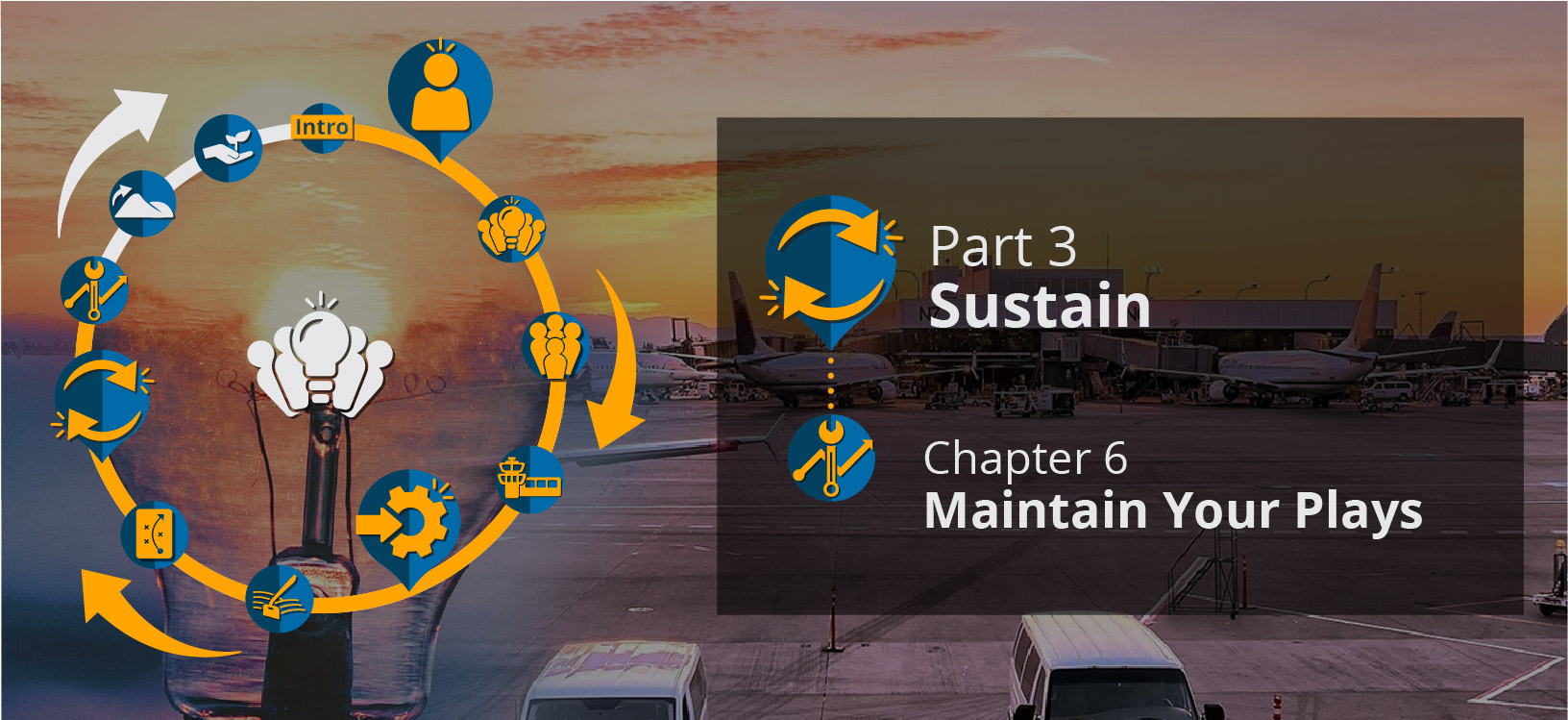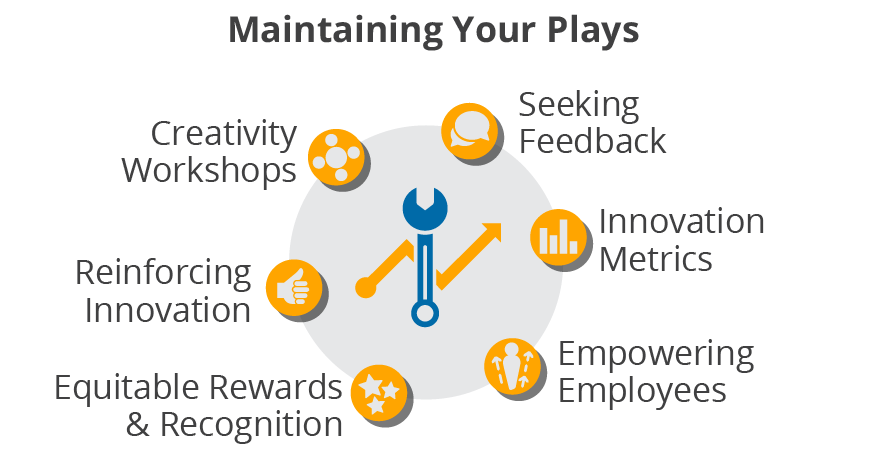

This is a Deep Dive page. Select the chapter for the Fast Track
Ways to Maintain Your Plays
Figure D6.1 introduces six potential ways to maintain your plays: seeking feedback, innovation metrics, equitable rewards and recognition, empowering your employees, reinforcing innovation, and creativity workshops.

Figure D6.1 Maintaining Your Plays
Seeking Feedback
Feedback is an integral part of determining how effective an activity has been. Without it, you are essentially rudderless, unable to know your directional heading. Feedback provides details on the "dashboard” of your organization, showing you how to mitigate specific issues. Consider some of these insights as you think“ll observations, recalibration of ideas, and mini experiments that provide fast feedback. What plays (in Chapter 5) appealed to you, and what have you noticed as you carried out each play? Collect information about the interactions between your team members, including any information about a particular innovative idea that you and your team decided to pursue, to assist you in realizing the success of your plays.
- Comment often yet constructively. Is frequent, constructive, and supportive feedback provided to the organization? Without regular feedback, staff may lose interest or erroneously believe the program has perished. Many of the plays offered in Chapter 5 initiate engagement with your team or airport partners. Coach, guide, and provide constructive comments to those involved so they know they are on the desired path as you pursue a culture of innovation. Make sure your team knows without a doubt that your organization's journey toward a culture of innovation is full steam ahead, and their participation is not only valued but needed.
- Acknowledge all ideas. Do ideas stay at the bottom of the “suggestion box,” or are they acknowledged? If ideas are not acknowledged, the commitment of the staff will be lost. This does not mean you have to implement every idea that comes through the proverbial suggestion box; rather, it just means letting individuals know where their ideas stand. It may be a timing component that keeps an idea from moving forward, or perhaps the idea does not align with the organization's vision and mission. Whatever the reason, providing prompt acknowledgement and disposition of ideas is key to motivating your team.
- Conduct employee engagement surveys. Nothing helps move an organization along faster than the ability to capture perceptions from your employees. Employee engagement or satisfaction surveys provide an anonymous setting for your staff to share their true insights on the organization. Honesty from both employees and leadership is essential for organizations pursuing a culture of innovation.
- Facilitate innovation awareness. Is time set aside in staff meetings to address innovation by presenting on the latest improvements made? Communicate updates from the board or executive team, results of hackathons and idea workshops, upcoming innovation events or training, highlights on innovation processes or methods, and upcoming awards ceremonies for innovators to create awareness and excitement within the organization as you press ahead with your innovation journey. These kinds of activities help reinforce other concepts covered in this list, such as collecting information, commenting constructively, and acknowledging ideas.
Innovation Metrics
Clearly identifying how an organization can measure a team's successes (or even failures) can strategically position you to make better decisions regarding your program going forward. And clarity about what is considered a successful step toward a culture of innovation will empower your employees to think with an innovative mindset. Consider the following ideas:
- Develop metrics. Have metrics been developed as a basis for the successful measurement of innovative ideas and the culture itself? Incorporate such metrics as a part of your core business functions. Knowing what success looks like, and how that applies to the vision and mission of the airport, enables your staff to utilize critical-thinking skills to adjust their efforts and ensure victory. Seek out opportunities to capture key industry benchmarking metrics to enable your organization to compare how it is performing against other airports.
- Understand metrics. While developing and deploying metrics is important for your airport and the organization, understanding them is equally important. All airport staff must understand the purpose behind metrics. Therefore, as you begin to introduce initiatives that support innovative culture, be sure to ask whether the metrics are based on the desired outcomes of the ideas and elements of the culture that influenced them. Ask whether your metrics align with initiatives that are important to your business and customers. It is important that airport team members and partners embrace these metrics and see alignment with the overall vision and mission of your airport.
Equitable Rewards and Recognition
Very few organizations maintain policies on rewards and recognition programs; such programs are typically scheduled as annual events or planned as a means to celebrate a recent major achievement of an organization. Rarely are the parameters of any rewards program highlighted or even documented so that employees know the target they are striving for. Consider incorporating the following components to further enhance your culture of innovation and avoid potential pitfalls of unintended consequences with rewards and recognition.
- Reward equitably. As you explore the best ways to reward and recognize individuals for their contributions to your culture of innovation, spend time discovering ways for your program to be more equitable. For example, if a core team of individuals worked on an innovative initiative with a few others from key departments, it is appropriate to include those collaborators from the other departments. Having clarity ahead of time about what behaviors are being rewarded will help ensure equitable actions when the time comes for rewards and recognition.
- Reward experimentation. A key to creating and sustaining a culture of innovation is the practice of rewarding and recognizing innovative behavior, including experimentation, even when the results are not immediately positive. Consider including individuals who do not typically have an equitable opportunity to participate, and ensure they receive recognition for their work. This can be an inventive way to include even more members in the culture of innovation initiative. This ensures that all can participate and individuals who can make valuable contributions to the work at hand are not inadvertently left out.
- Ensure recognition. Give out awards publicly so that all staff can recognize and witness contributions. This can not only be gratifying for those receiving an award but also encouraging to others to continue innovating. Rewarding the new behavior and providing tangible examples to the staff about expectations is an excellent way to encourage them to embrace this culture of innovation.
- Avoid unintended consequences. Ensure that your rewards and recognition program does not inadvertently reward negative behaviors, like jealousy or cheating. Recognition of an inclusive and innovative culture is what you are after, not unhealthy competition with one another.
For examples of rewards, consider the list presented in Cultivation Cycle in Chapter 4.
Empowering Your Employees
Many of the plays in Chapter 5 are meant to help empower your employees. After some time, look at the results of your plays and ensure
- Employee autonomy. Do all employees believe they have some level of autonomy to think independently and find new ways to solve problems? Without this, they will not offer their insights. Instead, employees will continue to falsely believe that innovative solutions being sought by the airport will come from an executive or management team rather than from across the organization.
- Consistency. Do leaders listen to, mentor, trust, and empower their teams? If not, the culture of innovation will wither on the vine. An innovative leader provides an encouraging and open setting for all to engage in the dialogue of resolving issues, yielding in a healthy and vibrant organization that is ready to tackle innovation.
- Significance. Team members that have both the skill and interest to carry out work assignments in a way that develops their innovative mindset will be much more persistent and give more feedback to the system. Staff that are valued and deemed “valuable” for the work they contribute will know they are significant.
Reinforcing Innovation
Many of the plays provided in Chapter 5 are designed to reinforce innovation across the organization. An organization's culture can either promote innovative values or create impasses for innovation to take hold. Consider integrating some of the following components to help further define the relationships between people and positions at an airport.
- Foster dialogue. Pursue opportunities to engage in dialogue that supports the organization's innovation strategy. Continual discussion about the airport's innovation strategy will assist employees with understanding their role, no matter their position on the organizational chart. Utilize the first few minutes of regular staff meetings to set the stage about the airport's drive for innovation and the role they can play. This reminds staff that innovation is a high priority, not just an afterthought or a passing fad.
- Provide equitable access. Ensure workshops, training functions, or brainstorming sessions on innovation are conducted across all functions and through all hierarchy levels. These sessions are an opportunity for individual employees to learn what innovation means for their field, what role they play in the innovation process, and what they can contribute. Doing so can drive the development of role models and action plans for everyone. This is also an excellent opportunity to substantiate changes to the various job descriptions in the organization, weaving elements and behaviors of innovation throughout each.
- Define expectations. Engage with employees to help them fully understand what the culture of innovation means for the airport and for themselves. It is necessary to provide information and develop skills to support the concepts of an innovative mindset. These can be accomplished through training seminars, workshops, or crash courses on innovation with content and scope adapted to the needs of specific employee groups. This is also an excellent opportunity to incorporate elements of an innovative mindset into annual performance review documents to help reinforce the desired behaviors.
Creativity Workshops
Providing opportunities for staff to collaborate through a variety of informal and formal mechanisms can assist staff with building relationships and bring clarity to daily tasks.
- Collaborative opportunities. Practice engaging team members across all functions to develop new ideas and solutions. Sponsor successive lunch meetings, enabling a cross section of the organization to come together and brainstorm new ideas and solutions to benefit the airport's business model while enhancing the customer experience. You could even provide a boxed lunch to let them know you appreciate their time and input.
- Facilitated activities. Find a facilitator to engage your team with exciting topics and challenging issues. Cross-functional team members will collaborate and work to resolve the challenge before them. Your team will emerge inspired toward innovation.
- Equipped to succeed. Ask employees to develop ideas to present to management. Training and development support should be provided for those who are not experienced in giving presentations. Then the best ideas can be selected by a panel consisting of management and subject matter experts, as well as through employee voting. The best ideas can be awarded and processed to the next phase of development.
Continue to Chapter 7 to learn how to nurture your program through the many barriers and challenges that will inevitably arise.



